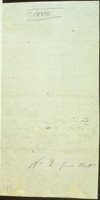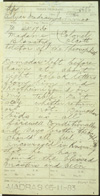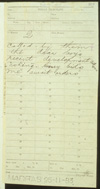Mahatma Letter No. 116: Difference between revisions
Pablo Sender (talk | contribs) No edit summary |
|||
| (9 intermediate revisions by 5 users not shown) | |||
| Line 1: | Line 1: | ||
{{Infobox MLbox | {{Infobox MLbox | ||
| header1 = People involved | | | header1 = People involved | | ||
| Line 11: | Line 7: | ||
| writtendate = unknown | | writtendate = unknown | ||
| receiveddate = November 25 or 27, 1883 - see [[Mahatma Letter No. 116#Context and background|below]] | | receiveddate = November 25 or 27, 1883 - see [[Mahatma Letter No. 116#Context and background|below]] | ||
| otherdate = | | otherdate = unknown | ||
| header3 = Places | | header3 = Places | ||
| sentfrom = Jammu | | sentfrom = Jammu | ||
| receivedat = [[Madras, India]] | | receivedat = [[Madras, India]] | ||
| vialocation = | | vialocation = unknown{{pad|9em}} | ||
}} | }} | ||
''' | This is '''Letter No. 116''' in ''' [[The Mahatma Letters to A. P. Sinnett (book)|''The Mahatma Letters to A. P. Sinnett'']], 4th chronological edition'''. It corresponds to '''Letter No. 128''' in '''Barker numbering.''' See below for [[Mahatma Letter No. 116#Context and background|Context and background]]. | ||
<br> | <br> | ||
<br> | <br> | ||
| Line 32: | Line 28: | ||
{{Col-break|width=55%}} | {{Col-break|width=55%}} | ||
No. 2 from Olcott | No. 2 from Olcott | ||
{{Col-break|width=3%}} | |||
{{Col-break|width=15%}} | {{Col-break|width=15%}} | ||
[ | [http://www.theosophy.wiki/mywiki/images/ML/116-0_Cover_sheet_7242.jpg http://www.theosophy.wiki/mywiki/images/ML/116-0_Cover_sheet_7242_thm.jpg] | ||
{{Col-break|width=30%}} | {{Col-break|width=30%}} | ||
| Line 48: | Line 47: | ||
INDIAN TELEGRAPH | INDIAN TELEGRAPH | ||
To Station Adyar Madras | To (Station) Adyar, Madras | ||
From (Station) Jammoo | |||
To (Person) [[Helena Petrovna Blavatsky|Madame Blavatsky]] | |||
Editor of [[The Theosophist (periodical)|the Theosophist]]. | |||
Damodar left before dawn at about eight o'clock letters from him and Koothumi found on my table — Don't say whether return or not — Damodar bids us all farewell conditionally and says brother | From (Person) [[Henry Steel Olcott|Colonel Olcott]] | ||
[[Damodar K. Mavalankar|Damodar]] left before dawn at about eight o'clock letters from him and [[Koot Hoomi|Koothumi]] found on my table — Don't say whether return or not — Damodar bids us all farewell conditionally and says brother [[theosophist]]s should all feel encouraged in knowing that he has found the blessed [[Masters of Wisdom|masters]] and been | |||
{{Col-break|width=3%}} | |||
{{Col-break|width=15%}} | {{Col-break|width=15%}} | ||
[ | [http://www.theosophy.wiki/mywiki/images/ML/116-1_7240.jpg http://www.theosophy.wiki/mywiki/images/ML/116-1_7240_thm.jpg] | ||
{{Col-break|width=30%}} | {{Col-break|width=30%}} | ||
| Line 71: | Line 74: | ||
{{Col-begin|width=98%}} | {{Col-begin|width=98%}} | ||
{{Col-break|width=55%}} | {{Col-break|width=55%}} | ||
by them. The dear boys recent | called by them. The dear boys recent development astonishing. Homey bids me await orders. | ||
Madras 25-11-83. Hour 17-30. | Madras 25-11-83. Hour 17-30. | ||
{{Col-break|width=3%}} | |||
{{Col-break|width=15%}} | {{Col-break|width=15%}} | ||
[ | [http://www.theosophy.wiki/mywiki/images/ML/116-2_7241.jpg http://www.theosophy.wiki/mywiki/images/ML/116-2_7241_thm.jpg] | ||
{{Col-break|width=30%}} | {{Col-break|width=30%}} | ||
'''NOTES:''' | '''NOTES:''' | ||
* | * '''Homey''' was probably a misspelling of [[Koot Hoomi]] by the telegraph operator. | ||
{{Col-end}} | {{Col-end}} | ||
| Line 87: | Line 92: | ||
== Context and background == | == Context and background == | ||
A few hours later, [[H. S. Olcott|Olcott]] sent a second telegram explaining in more detail, and including the message from Damodar, which he had found along with that of the Mahatma’s. Olcott related how, even before he sent the telegram to H.P.B. he had an instinct to take Damodar’s luggage, his trunk and bedding, and pack them away under his own cot. | |||
That evening, he received a telegram in reply from H.P.B. She told him that a Master had told her that Damodar would return, and she added that the Colonel must not let Damodar’s luggage, especially his bedding, be touched by anyone else. "That was strange, was it not," asks the Colonel, "that she, at Madras, i.e., some 2,000 miles away — should tell me to do the very thing it had been my first impulse to do on finding out about the lad’s departure?" | |||
In ''Old Diary Leaves'' vol. 3, p. 54, Olcott makes the following comments: | |||
:It was on the 25th of November, at daylight, that Damodar left us: he returned in the evening of the 27th — after an absence of some sixty hours, but how changed! He left, a delicate-framed, pale student-like young man, frail, timid, deferential; he returned with his olive face bronzed several shades darker, seemingly robust, tough, and wiry, bold and energetic in manner: we could scarcely realise that he was the same person. | |||
Damodar describes his experience with considerable restraint, though he was permitted to tell of it. It was first published in ''The Theosophist'' for Dec.-Jan. 1883-84, pp. 61-2. It is now found in the book ''Damodar'' by Sven Eek (pp. 333-36); and the story is related in Geoffrey Barborka’s book ''The Mahatmas and Their Letters'' (pp. 247-50). Here is the pertinent part: | |||
:. . . I had the good fortune of being sent for, and permitted to visit a Sacred Ashram where I remained for a few days in the blessed company of several of the much doubted Mahatmas of Himavat and Their disciples. There I met not only my beloved Gurudeva and Col. Olcott’s Master (Morya), but several others of the Fraternity, including One of the Highest. I regret [that] the extremely personal nature of my visit to those thrice blessed regions prevents my saying more of it. Suffice it that the place I was permitted to visit is in the Himalayas, not in any fanciful Summer Land, and that I saw Him in my own sthula sarira [physical body] and found my Master identical with the form I had seen in the earlier days of my Chelaship. | |||
== Physical description of letter == | == Physical description of letter == | ||
The original is in the British Library, Folio 3. [[George Linton]] and [[Virginia Hanson]] described the letter and its companion, [[Mahatma Letter No. | The original is in the British Library, Folio 3. [[George Linton]] and [[Virginia Hanson]] described the letter and its companion, [[Mahatma Letter No. 115|No. 115]], in this way: | ||
<blockquote> | <blockquote> | ||
Two telegrams from [[Henry Steel Olcott|HSO]] to [[Helena Petrovna Blavatsky|HPB]] regarding the disappearance of [[Damodar K. Mavalankar|DKM]]. The note on [[Mahatma Letter No. | Two telegrams from [[Henry Steel Olcott|HSO]] to [[Helena Petrovna Blavatsky|HPB]] regarding the disappearance of [[Damodar K. Mavalankar|DKM]]. The note on [[Mahatma Letter No. 115|ML-129]] from KH is in blue pencil, added probably while the telegram was in transit.<ref>George E. Linton and Virginia Hanson, eds., ''Readers Guide to The Mahatma Letters to A. P. Sinnett'' (Adyar, Chennai, India: Theosophical Publishing House, 1972), 184.</ref> | ||
</blockquote> | </blockquote> | ||
| Line 103: | Line 119: | ||
== Notes == | == Notes == | ||
<references/> | <references/> | ||
[[Category:ML from H. S. Olcott]] | |||
[[Category:ML needs background]] | |||
[[Category:ML to H. P. Blavatsky]] | |||
[[Category:ML with images]] | |||
[[Category:ML needs commentary]] | |||
Latest revision as of 15:01, 11 April 2022
| Quick Facts | |
|---|---|
| People involved | |
| Written by: | H. S. Olcott |
| Received by: | H. P. Blavatsky |
| Sent via: | unknown |
| Dates | |
| Written on: | unknown |
| Received on: | November 25 or 27, 1883 - see below |
| Other dates: | unknown |
| Places | |
| Sent from: | Jammu |
| Received at: | Madras, India |
| Via: | unknown |
This is Letter No. 116 in The Mahatma Letters to A. P. Sinnett, 4th chronological edition. It corresponds to Letter No. 128 in Barker numbering. See below for Context and background.
< Prev letter chrono
Next letter chrono >
< Prev letter Barker
Next letter Barker >
Cover sheet
|
No. 2 from Olcott |
|
NOTES: |
Page 1 transcription, image, and notes
|
INDIAN TELEGRAPH To (Station) Adyar, Madras From (Station) Jammoo To (Person) Madame Blavatsky Editor of the Theosophist. From (Person) Colonel Olcott Damodar left before dawn at about eight o'clock letters from him and Koothumi found on my table — Don't say whether return or not — Damodar bids us all farewell conditionally and says brother theosophists should all feel encouraged in knowing that he has found the blessed masters and been |
|
NOTES: |
Page 2
|
called by them. The dear boys recent development astonishing. Homey bids me await orders. Madras 25-11-83. Hour 17-30. |
NOTES:
|
Context and background
A few hours later, Olcott sent a second telegram explaining in more detail, and including the message from Damodar, which he had found along with that of the Mahatma’s. Olcott related how, even before he sent the telegram to H.P.B. he had an instinct to take Damodar’s luggage, his trunk and bedding, and pack them away under his own cot.
That evening, he received a telegram in reply from H.P.B. She told him that a Master had told her that Damodar would return, and she added that the Colonel must not let Damodar’s luggage, especially his bedding, be touched by anyone else. "That was strange, was it not," asks the Colonel, "that she, at Madras, i.e., some 2,000 miles away — should tell me to do the very thing it had been my first impulse to do on finding out about the lad’s departure?"
In Old Diary Leaves vol. 3, p. 54, Olcott makes the following comments:
- It was on the 25th of November, at daylight, that Damodar left us: he returned in the evening of the 27th — after an absence of some sixty hours, but how changed! He left, a delicate-framed, pale student-like young man, frail, timid, deferential; he returned with his olive face bronzed several shades darker, seemingly robust, tough, and wiry, bold and energetic in manner: we could scarcely realise that he was the same person.
Damodar describes his experience with considerable restraint, though he was permitted to tell of it. It was first published in The Theosophist for Dec.-Jan. 1883-84, pp. 61-2. It is now found in the book Damodar by Sven Eek (pp. 333-36); and the story is related in Geoffrey Barborka’s book The Mahatmas and Their Letters (pp. 247-50). Here is the pertinent part:
- . . . I had the good fortune of being sent for, and permitted to visit a Sacred Ashram where I remained for a few days in the blessed company of several of the much doubted Mahatmas of Himavat and Their disciples. There I met not only my beloved Gurudeva and Col. Olcott’s Master (Morya), but several others of the Fraternity, including One of the Highest. I regret [that] the extremely personal nature of my visit to those thrice blessed regions prevents my saying more of it. Suffice it that the place I was permitted to visit is in the Himalayas, not in any fanciful Summer Land, and that I saw Him in my own sthula sarira [physical body] and found my Master identical with the form I had seen in the earlier days of my Chelaship.
Physical description of letter
The original is in the British Library, Folio 3. George Linton and Virginia Hanson described the letter and its companion, No. 115, in this way:
Two telegrams from HSO to HPB regarding the disappearance of DKM. The note on ML-129 from KH is in blue pencil, added probably while the telegram was in transit.[1]
Publication history
Commentary about this letter
Notes
- ↑ George E. Linton and Virginia Hanson, eds., Readers Guide to The Mahatma Letters to A. P. Sinnett (Adyar, Chennai, India: Theosophical Publishing House, 1972), 184.


